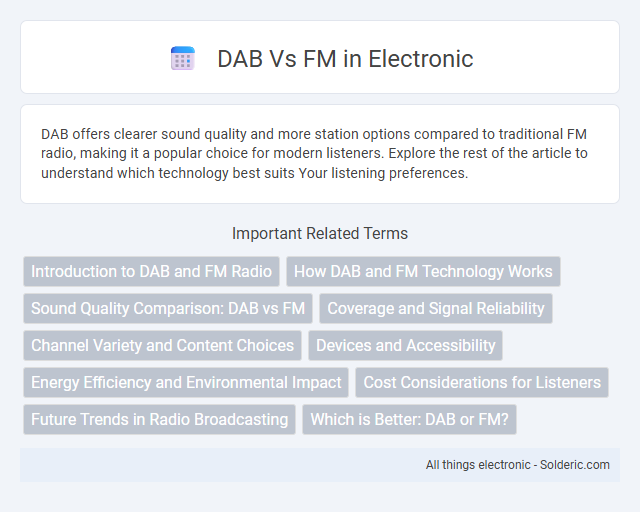DAB offers clearer sound quality and more station options compared to traditional FM radio, making it a popular choice for modern listeners. Explore the rest of the article to understand which technology best suits Your listening preferences.
Comparison Table
| Feature | DAB (Digital Audio Broadcasting) | FM (Frequency Modulation) |
|---|---|---|
| Signal Type | Digital | Analog |
| Audio Quality | Clear, consistent sound, less interference | Subject to static and signal degradation |
| Frequency Range | 174-240 MHz (VHF Band III) | 88-108 MHz |
| Coverage | Limited by multiplex network; varies by location | Wide coverage, depends on transmitter power |
| Number of Stations | Multiple stations on a single frequency (multiplexing) | One station per frequency |
| Reception Devices | DAB-enabled radios, digital receivers | FM radios, car stereos, most traditional receivers |
| Data Services | Supports text, images, and program info | Limited to RDS (basic text info) |
| Power Consumption | Generally higher due to digital processing | Lower power usage |
| Popularity | Growing, especially in Europe and Australia | Widespread global adoption |
Introduction to DAB and FM Radio
DAB (Digital Audio Broadcasting) and FM (Frequency Modulation) are two prominent radio transmission technologies delivering audio content. DAB offers digital sound quality, a broader station selection, and reduced interference compared to FM's traditional analog signals. Your choice between DAB and FM impacts audio clarity, station variety, and coverage depending on device compatibility and location.
How DAB and FM Technology Works
DAB (Digital Audio Broadcasting) transmits audio signals using digital data packets, which are compressed and encoded to deliver high-quality sound with reduced interference. FM (Frequency Modulation) broadcasts analog signals by varying the frequency of the carrier wave to transmit audio information, making it susceptible to noise and signal degradation. DAB uses multiplexing to transmit multiple stations on a single frequency, while FM allocates separate frequencies to each station, impacting spectrum efficiency.
Sound Quality Comparison: DAB vs FM
Digital Audio Broadcasting (DAB) delivers superior sound quality compared to Frequency Modulation (FM) due to its digital signal processing, which minimizes noise and interference. FM signals are analog and susceptible to static, multipath distortion, and signal degradation, especially in fringe reception areas. DAB's consistent bit rate ensures clearer audio clarity and supports stereo sound without the hiss or crackle commonly experienced in FM broadcasts.
Coverage and Signal Reliability
DAB (Digital Audio Broadcasting) offers more consistent signal reliability with less interference and dropouts compared to FM (Frequency Modulation), especially in urban areas and challenging terrains. DAB provides wider coverage through multiplexing, allowing multiple stations to broadcast on a single frequency, which enhances reception stability across regions. Choosing DAB improves your listening experience by reducing signal fading and extending reliable access to digital radio content.
Channel Variety and Content Choices
DAB offers a significantly wider channel variety compared to FM, providing access to numerous digital-only stations and specialized content that FM cannot support due to bandwidth limitations. Your listening experience benefits from clearer sound quality and more diverse programming options, ranging from niche genres to talk shows. FM remains reliable in coverage but is restricted to fewer channels and limited content diversity.
Devices and Accessibility
DAB (Digital Audio Broadcasting) devices offer enhanced accessibility with clearer sound quality and a wider range of station options compared to traditional FM radios, which rely on analog signals and are more susceptible to interference. Modern DAB radios often include features such as text displays, ease of tuning, and compatibility with online streaming, improving user interaction and convenience. Despite these advantages, FM radios remain more prevalent in many regions due to their lower cost and widespread availability in vehicles and portable devices.
Energy Efficiency and Environmental Impact
DAB (Digital Audio Broadcasting) radios consume significantly less energy than traditional FM receivers due to optimized transmission protocols and efficient signal processing. This reduced power consumption lowers your overall carbon footprint, making DAB a more environmentally friendly option. Enhanced spectrum efficiency also allows broadcasters to transmit more channels with less energy, contributing to sustainable media consumption.
Cost Considerations for Listeners
DAB radios often come with higher upfront costs compared to traditional FM receivers due to advanced digital technology and additional features. However, your ongoing expenses may decrease as DAB broadcasts typically incur no extra subscription fees, unlike certain FM stations with premium content. Investing in DAB can offer long-term savings and enhanced audio quality that justify the initial expenditure for frequent radio listeners.
Future Trends in Radio Broadcasting
DAB (Digital Audio Broadcasting) is rapidly advancing with enhanced audio quality, increased channel capacity, and interactive features, positioning it as the future standard over traditional FM broadcasting. FM radio remains widespread due to its reliability and extensive infrastructure, but it faces limitations in spectrum efficiency and audio clarity. Technological innovations and regulatory support are accelerating the transition to DAB, making digital radio the centerpiece of future radio broadcasting strategies.
Which is Better: DAB or FM?
DAB offers superior sound quality and more station options with less interference compared to FM, making it ideal for digital radio enthusiasts. FM signals have broader coverage in remote areas and better compatibility with older radios, which benefits users with legacy devices. Your choice depends on whether you prioritize audio clarity and variety (DAB) or wider accessibility and simplicity (FM).
DAB vs FM Infographic

 solderic.com
solderic.com